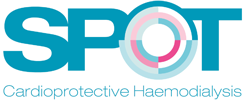Home / FlashMed
FlashMed
| Titolo | Frequent Hemodialysis Schedules Are Associated with Reduced Levels of Dialysis-induced Cardiac Injury (Myocardial Stunning) |
| Autore | Helen J. Jefferies,* Bhupinder Virk,± Brigitte Schiller,± John Moran,± and Christopher W. McIntyre*§ |
| Referenza | Clin J Am Soc Nephrol 2011; 6: 1326-1332 |
| Contenuto | Background and objectives Recurrent hemodialysis (HD)-induced ischemic cardiac injury (myocardial stunning) is common and associated with high ultrafiltration (UF) requirements, intradialytic hypotension, longterm loss of systolic function, increased likelihood of cardiovascular events, and death. More frequent HD regimens are associated with lower UF requirements and improved hemodynamic tolerability, improved cardiovascular outcomes, and reduced mortality compared with conventional thrice-weekly HD. This study investigated the hypothesis that modification of UF volume and rate with more frequent HD therapies would abrogate dialysis-induced myocardial stunning. Design, settings, participants, & measurements A cross-sectional study of 46 patients established on hemodialysis _3 months compared four groups receiving the current range of quotidian therapies: conventional thrice-weekly HD (CHD3); more-frequent HD five to six times/week in a center (CSD) and at home (HSD); and home nocturnal HD (HN). Serial echocardiography quantitatively assessed regional systolic function to identify intradialytic left ventricular regional wall motion abnormalities (RWMAs). Cardiac troponin T (cTnT), N-terminal prohormone brain natriuretic peptide (NT-proBNP), and inflammatory markers were quantified. Results More frequent HD regimens were associated with lower UF volumes and rates compared with CHD3. Intradialytic fall in systolic BP was reduced in CSD and HSD groups and abolished in HN group. Mean RWMAs per patient reduced with increasing dialysis intensity (CHD3 _ CSD _ HSD _ HN). Homebased groups demonstrated lower high-sensitivity C-reative protein levels, with trends to lower cTnT and NT-proBNP levels in the more frequent groups. Conclusions Frequent HD regimes are associated with less dialysis-induced myocardial stunning compared with conventional HD. This may contribute to improved outcomes associated with frequent HD therapies. |
| Data | 04.08.2011 |
| Lista completa |
|







